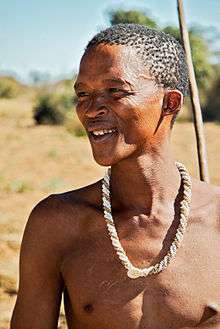Hunter-gatherer
A hunter-gatherer is a human living in a society in which most or all food is obtained by foraging (collecting wild plants and pursuing wild animals). Hunter-gatherer societies stand in contrast to agricultural societies, which rely mainly on domesticated species.
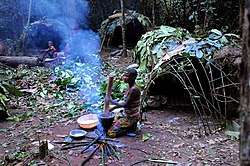
Hunting and gathering was humanity's first and most successful adaptation, occupying at least 90 percent of human history.[1] Following the invention of agriculture, hunter-gatherers who did not change have been displaced or conquered by farming or pastoralist groups in most parts of the world.[2]
Only a few contemporary societies are classified as hunter-gatherers, and many supplement their foraging activity with horticulture or pastoralism.[3][4] Contrary to common misconception, hunter-gatherers are mostly well-fed, rather than starving.[5]
Archaeological evidence
| Part of a series on |
| Economic systems |
|---|
|
By ideology
|
|
By coordination |
|
By regional model
|
|
Sectors |
|
Property types |
|
Coordination |
|
During the 1970s, Lewis Binford suggested that early humans obtained food via scavenging, not hunting.[6] Early humans in the Lower Paleolithic lived in forests and woodlands, which allowed them to collect seafood, eggs, nuts, and fruits besides scavenging. Rather than killing large animals for meat, according to this view, they used carcasses of such animals that had either been killed by predators or that had died of natural causes.[7] Archaeological and genetic data suggest that the source populations of Paleolithic hunter-gatherers survived in sparsely wooded areas and dispersed through areas of high primary productivity while avoiding dense forest cover.[8]
According to the endurance running hypothesis, long-distance running as in persistence hunting, a method still practiced by some hunter-gatherer groups in modern times, was likely the driving evolutionary force leading to the evolution of certain human characteristics. This hypothesis does not necessarily contradict the scavenging hypothesis: both subsistence strategies could have been in use sequentially, alternating or even simultaneously.
Hunting and gathering was presumably the subsistence strategy employed by human societies beginning some 1.8 million years ago, by Homo erectus, and from its appearance some 0.2 million years ago by Homo sapiens. Prehistoric hunter-gatherers lived in groups that consisted of several families resulting in a size of a few dozen people.[9] It remained the only mode of subsistence until the end of the Mesolithic period some 10,000 years ago, and after this was replaced only gradually with the spread of the Neolithic Revolution.
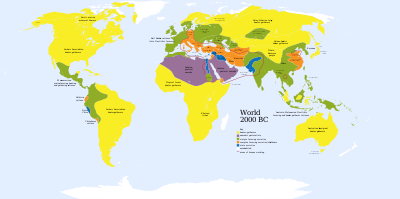
Starting at the transition between the Middle to Upper Paleolithic period, some 80,000 to 70,000 years ago, some hunter-gatherers bands began to specialize, concentrating on hunting a smaller selection of (often larger) game and gathering a smaller selection of food. This specialization of work also involved creating specialized tools such as fishing nets, hooks, and bone harpoons.[10] The transition into the subsequent Neolithic period is chiefly defined by the unprecedented development of nascent agricultural practices. Agriculture originated as early as 12,000 years ago in the Middle East, and also independently originated in many other areas including Southeast Asia, parts of Africa, Mesoamerica, and the Andes.
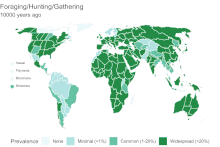
Forest gardening was also being used as a food production system in various parts of the world over this period. Forest gardens originated in prehistoric times along jungle-clad river banks and in the wet foothills of monsoon regions. In the gradual process of families improving their immediate environment, useful tree and vine species were identified, protected and improved, whilst undesirable species were eliminated. Eventually superior introduced species were selected and incorporated into the gardens.[11]
Many groups continued their hunter-gatherer ways of life, although their numbers have continually declined, partly as a result of pressure from growing agricultural and pastoral communities. Many of them reside in the developing world, either in arid regions or tropical forests. Areas that were formerly available to hunter-gatherers were—and continue to be—encroached upon by the settlements of agriculturalists. In the resulting competition for land use, hunter-gatherer societies either adopted these practices or moved to other areas. In addition, Jared Diamond has blamed a decline in the availability of wild foods, particularly animal resources. In North and South America, for example, most large mammal species had gone extinct by the end of the Pleistocene—according to Diamond, because of overexploitation by humans,[12] one of several explanations offered for the Quaternary extinction event there.
As the number and size of agricultural societies increased, they expanded into lands traditionally used by hunter-gatherers. This process of agriculture-driven expansion led to the development of the first forms of government in agricultural centers, such as the Fertile Crescent, Ancient India, Ancient China, Olmec, Sub-Saharan Africa and Norte Chico.
As a result of the now near-universal human reliance upon agriculture, the few contemporary hunter-gatherer cultures usually live in areas unsuitable for agricultural use.
Archaeologists can use evidence such as stone tool use to track hunter-gatherer activities, including mobility.[13]
Common characteristics
Habitat and population
Most hunter-gatherers are nomadic or semi-nomadic and live in temporary settlements. Mobile communities typically construct shelters using impermanent building materials, or they may use natural rock shelters, where they are available.
Some hunter-gatherer cultures, such as the indigenous peoples of the Pacific Northwest Coast and the Yakuts, lived in particularly rich environments that allowed them to be sedentary or semi-sedentary. Amongst the earliest example of permanent settlements is the Osipovka culture (14–10.3 thousand years ago),[14] which lived in a fish-rich environment that allowed them to be able to stay at the same place all year.[15] One group, the Chumash, had the highest recorded population density of any known hunter and gatherer society with an estimated 21.6 persons per square mile.[16]
Social and economic structure
Hunter-gatherers tend to have an egalitarian social ethos,[17] although settled hunter-gatherers (for example, those inhabiting the Northwest Coast of North America) are an exception to this rule.[18][19] Nearly all African hunter-gatherers are egalitarian, with women roughly as influential and powerful as men.[20] For example, the San people or "Bushmen" of southern Africa have social customs that strongly discourage hoarding and displays of authority, and encourage economic equality via sharing of food and material goods.[21] Karl Marx defined this socio-economic system as primitive communism.[22]
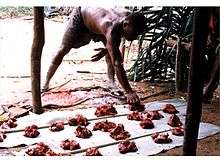
The egalitarianism typical of human hunters and gatherers is never total, but is striking when viewed in an evolutionary context. One of humanity's two closest primate relatives, chimpanzees, are anything but egalitarian, forming themselves into hierarchies that are often dominated by an alpha male. So great is the contrast with human hunter-gatherers that it is widely argued by palaeoanthropologists that resistance to being dominated was a key factor driving the evolutionary emergence of human consciousness, language, kinship and social organization.[23][24][25]
Anthropologists maintain that hunter-gatherers do not have permanent leaders; instead, the person taking the initiative at any one time depends on the task being performed.[26][27][28] In addition to social and economic equality in hunter-gatherer societies, there is often, though not always, sexual parity as well.[26] Hunter-gatherers are often grouped together based on kinship and band (or tribe) membership.[29] Postmarital residence among hunter-gatherers tends to be matrilocal, at least initially.[30] Young mothers can enjoy childcare support from their own mothers, who continue living nearby in the same camp.[31] The systems of kinship and descent among human hunter-gatherers were relatively flexible, although there is evidence that early human kinship in general tended to be matrilineal.[32]
One common arrangement is the sexual division of labour, with women doing most of the gathering, while men concentrate on big game hunting. In all hunter-gatherer societies, women appreciate the meat brought back to camp by men. An illustrative account is Megan Biesele's study of the southern African Ju/'hoan, 'Women Like Meat'.[33] Recent archaeological research suggests that the sexual division of labor was the fundamental organisational innovation that gave Homo sapiens the edge over the Neanderthals, allowing our ancestors to migrate from Africa and spread across the globe.[34]
A 1986 study found most hunter-gatherers have a symbolically structured sexual division of labour.[35] However, it is true that in a small minority of cases, women hunt the same kind of quarry as men, sometimes doing so alongside men. Among the Ju'/hoansi people of Namibia, women help men track down quarry.[36] Women in the Australian Martu also primarily hunt small animals like lizards to feed their children and maintain relations with other women.[37]
.jpg)
At the 1966 "Man the Hunter" conference, anthropologists Richard Borshay Lee and Irven DeVore suggested that egalitarianism was one of several central characteristics of nomadic hunting and gathering societies because mobility requires minimization of material possessions throughout a population. Therefore, no surplus of resources can be accumulated by any single member. Other characteristics Lee and DeVore proposed were flux in territorial boundaries as well as in demographic composition.
At the same conference, Marshall Sahlins presented a paper entitled, "Notes on the Original Affluent Society", in which he challenged the popular view of hunter-gatherers lives as "solitary, poor, nasty, brutish and short", as Thomas Hobbes had put it in 1651. According to Sahlins, ethnographic data indicated that hunter-gatherers worked far fewer hours and enjoyed more leisure than typical members of industrial society, and they still ate well. Their "affluence" came from the idea that they were satisfied with very little in the material sense.[38] Later, in 1996, Ross Sackett performed two distinct meta-analyses to empirically test Sahlin's view. The first of these studies looked at 102 time-allocation studies, and the second one analyzed 207 energy-expenditure studies. Sackett found that adults in foraging and horticultural societies work, on average, about 6.5 hours a day, whereas people in agricultural and industrial societies work on average 8.8 hours a day.[39]
Researchers Gurven and Kaplan have estimated that around 57% of hunter-gatherers reach the age of 15. Of those that reach 15 years of age, 64% continue to live to or past the age of 45. This places the life expectancy between 21 and 37 years.[40] They further estimate that 70% of deaths are due to diseases of some kind, 20% of deaths come from violence or accidents and 10% are due to degenerative diseases.
Mutual exchange and sharing of resources (i.e., meat gained from hunting) are important in the economic systems of hunter-gatherer societies.[29] Therefore, these societies can be described as based on a "gift economy."
A 2010 paper argued that while hunter-gatherers may have lower levels of inequality than modern, industrialised societies, that does not mean inequality does not exist. The researchers estimated that the average Gini coefficient amongst hunter-gatherers was 0.25, equivalent to the country of Denmark in 2007. In addition, wealth transmission across generations was also a feature of hunter-gatherers, meaning that "wealthy" hunter-gatherers, within the context of their communities, were more likely to have children as wealthy as them than poorer members of their community and indeed hunter-gatherer societies demonstrate an understanding of social stratification. Thus while the researchers agreed that hunter-gatherers were more egalitarian than modern societies, prior characterisations of them living in a state of egalitarian primitive communism were inaccurate and misleading.[41]
Variability
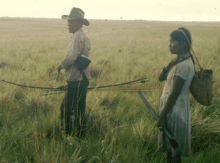
Hunter-gatherer societies manifest significant variability, depending on climate zone/life zone, available technology, and societal structure. Archaeologists examine hunter-gatherer tool kits to measure variability across different groups. Collard et al. (2005) found temperature to be the only statistically significant factor to impact hunter-gatherer tool kits.[42] Using temperature as a proxy for risk, Collard et al.'s results suggest that environments with extreme temperatures pose a threat to hunter-gatherer systems significant enough to warrant increased variability of tools. These results support Torrence's (1989) theory that risk of failure is indeed the most important factor in determining the structure of hunter-gatherer toolkits.[43]
One way to divide hunter-gatherer groups is by their return systems. James Woodburn uses the categories "immediate return" hunter-gatherers for egalitarian and "delayed return" for nonegalitarian. Immediate return foragers consume their food within a day or two after they procure it. Delayed return foragers store the surplus food (Kelly,[44] 31).
Hunting-gathering was the common human mode of subsistence throughout the Paleolithic, but the observation of current-day hunters and gatherers does not necessarily reflect Paleolithic societies; the hunter-gatherer cultures examined today have had much contact with modern civilization and do not represent "pristine" conditions found in uncontacted peoples.[45]
The transition from hunting and gathering to agriculture is not necessarily a one way process. It has been argued that hunting and gathering represents an adaptive strategy, which may still be exploited, if necessary, when environmental change causes extreme food stress for agriculturalists.[46] In fact, it is sometimes difficult to draw a clear line between agricultural and hunter-gatherer societies, especially since the widespread adoption of agriculture and resulting cultural diffusion that has occurred in the last 10,000 years.[47] This anthropological view has remained unchanged since the 1960s.
Nowadays, some scholars speak about the existence within cultural evolution of the so-called mixed-economies or dual economies which imply a combination of food procurement (gathering and hunting) and food production or when foragers have trade relations with farmers.[48]
Modern and revisionist perspectives
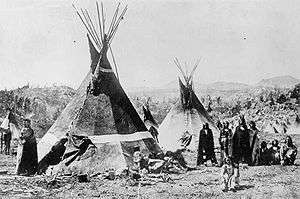
Some of the theorists who advocate this "revisionist" critique imply that, because the "pure hunter-gatherer" disappeared not long after colonial (or even agricultural) contact began, nothing meaningful can be learned about prehistoric hunter-gatherers from studies of modern ones (Kelly,[49] 24-29; see Wilmsen[50])
Lee and Guenther have rejected most of the arguments put forward by Wilmsen.[51][52][53] Doron Shultziner and others have argued that we can learn a lot about the life-styles of prehistoric hunter-gatherers from studies of contemporary hunter-gatherers—especially their impressive levels of egalitarianism.[54]
Many hunter-gatherers consciously manipulate the landscape through cutting or burning undesirable plants while encouraging desirable ones, some even going to the extent of slash-and-burn to create habitat for game animals. These activities are on an entirely different scale to those associated with agriculture, but they are nevertheless domestication on some level. Today, almost all hunter-gatherers depend to some extent upon domesticated food sources either produced part-time or traded for products acquired in the wild.
Some agriculturalists also regularly hunt and gather (e.g., farming during the frost-free season and hunting during the winter). Still others in developed countries go hunting, primarily for leisure. In the Brazilian rainforest, those groups that recently did, or even continue to, rely on hunting and gathering techniques seem to have adopted this lifestyle, abandoning most agriculture, as a way to escape colonial control and as a result of the introduction of European diseases reducing their populations to levels where agriculture became difficult.
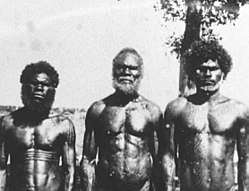
There are nevertheless a number of contemporary hunter-gatherer peoples who, after contact with other societies, continue their ways of life with very little external influence or with modifications that perpetuate the viability of hunting and gathering in the 21st century.[3] One such group is the Pila Nguru (Spinifex people) of Western Australia, whose habitat in the Great Victoria Desert has proved unsuitable for European agriculture (and even pastoralism). Another are the Sentinelese of the Andaman Islands in the Indian Ocean, who live on North Sentinel Island and to date have maintained their independent existence, repelling attempts to engage with and contact them.[56][57] The Savanna Pumé of Venezuela also live in an area that is inhospitable to large scale economic exploitation and maintain their subsistence based on hunting and gathering, as well as incorporating a small amount of manioc horticulture that supplements, but is not replacing, reliance on foraged foods.[58]
Americas
- See also: Paleo-Indians period (Canada) and History of Mesoamerica (Paleo-Indian)
Evidence suggests big-game hunter-gatherers crossed the Bering Strait from Asia (Eurasia) into North America over a land bridge (Beringia), that existed between 47,000–14,000 years ago.[59] Around 18,500–15,500 years ago, these hunter-gatherers are believed to have followed herds of now-extinct Pleistocene megafauna along ice-free corridors that stretched between the Laurentide and Cordilleran ice sheets.[60] Another route proposed is that, either on foot or using primitive boats, they migrated down the Pacific coast to South America.[61][62]
Hunter-gatherers would eventually flourish all over the Americas, primarily based in the Great Plains of the United States and Canada, with offshoots as far east as the Gaspé Peninsula on the Atlantic coast, and as far south as Chile, Monte Verde. American hunter-gatherers were spread over a wide geographical area, thus there were regional variations in lifestyles. However, all the individual groups shared a common style of stone tool production, making knapping styles and progress identifiable. This early Paleo-Indian period lithic reduction tool adaptations have been found across the Americas, utilized by highly mobile bands consisting of approximately 25 to 50 members of an extended family.[63]
The Archaic period in the Americas saw a changing environment featuring a warmer more arid climate and the disappearance of the last megafauna.[64] The majority of population groups at this time were still highly mobile hunter-gatherers. Individual groups started to focus on resources available to them locally, however, and thus archaeologists have identified a pattern of increasing regional generalization, as seen with the Southwest, Arctic, Poverty Point, Dalton and Plano traditions. These regional adaptations would become the norm, with reliance less on hunting and gathering, with a more mixed economy of small game, fish, seasonally wild vegetables and harvested plant foods.[65][66]
See also
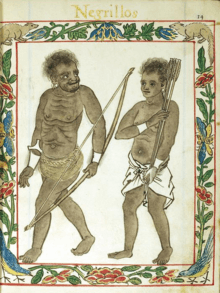
- Beachcombing
- Nomads
- Cro-Magnon
- Homo floresiensis
- Human migration
- Human history
- Indigenous peoples
- Neanderthals
- Neolithic Revolution
- Origins of society
- Paleolithic
- Prehistoric music
- Primitive skills
- Stateless society
- Tribe
- Clan
- Caucasian Hunter-Gatherer
Modern hunter-gatherer groups
- Aeta people
- Aka people
- Andamanese people
- Angu people
- Awá-Guajá people
- Batek people
- Efé people
- Fuegians
- Hadza people
- Indigenous Australians
- Indigenous peoples of the Pacific Northwest Coast
- Inuit people
- Iñupiat
- Jarawa people (Andaman Islands)
- Kawahiva people
- Maniq people
- Mbuti people
- Mlabri people
- Moriori people
- Nukak people
- Onge people
- Penan people
- Pirahã people
- San people
Sayesie Dene
- Semang people
- Sentinelese people
- Spinifex People
- Tjimba people
- Yakuts
- Yaruro (Pumé) people
- Ye'kuana people
- Yupik people
Social movements
- Anarcho-primitivism, which strives for the abolishment of civilization and the return to a life in the wild.
- Freeganism involves gathering of food (and sometimes other materials) in the context of an urban or suburban environment.
- Gleaning involves the gathering of food that traditional farmers have left behind in their fields.
- Paleolithic diet, which strives to achieve a diet similar to that of ancient hunter-gatherer groups.
- Paleolithic lifestyle, which extends the paleolithic diet to other elements of the hunter-gatherer way of life, such as movement and contact with nature
References
- Lee, Richard B.; Daly, Richard Heywood (1999). Cambridge Encyclopedia of Hunters and Gatherers. Cambridge University Press. p. inside front cover. ISBN 978-0521609197.
- Stephens, Lucas; Fuller, Dorian; Boivin, Nicole; Rick, Torben; Gauthier, Nicolas; Kay, Andrea; Marwick, Ben; Armstrong, Chelsey Geralda; Barton, C. Michael (2019-08-30). "Archaeological assessment reveals Earth's early transformation through land use". Science. 365 (6456): 897–902. doi:10.1126/science.aax1192. hdl:10150/634688. ISSN 0036-8075. PMID 31467217.
- Codding, Brian F.; Kramer, Karen L., eds. (2016). Why Forage? Hunters and Gatherers in the Twenty-first Century. Santa Fe; Albuquerque: School for Advanced Research, University of New Mexico Press. ISBN 978-0826356963.
- Greaves, Russell D.; et al. (2016). "Economic activities of twenty-first century foraging populations". Why Forage? Hunters and Gatherers in the Twenty-First Century. Santa Fe, Albuquerque: School for Advanced Research, University of New Mexico Press. pp. 241–262. ISBN 978-0826356963.
- Visualizing Human Geography, Second edition, Alyson L. Greiner
- Binford, Louis (1986). "Human ancestors: Changing views of their behavior". Journal of Anthropological Archaeology. 3: 235–257. doi:10.1016/0278-4165(84)90003-5.
- The Last Rain Forests: A World Conservation Atlas by David Attenborough, Mark Collins
- Gavashelishvili, A.; Tarkhnishvili, D. (2016). "Biomes and human distribution during the last ice age". Global Ecology and Biogeography. 25 (5): 563. doi:10.1111/geb.12437.
- Groeneveld, Emma (9 December 2016). "Prehistoric Hunter-Gatherer Societies". Ancient History Encyclopedia. Retrieved 9 April 2018.
- Fagan, B. (1989). People of the Earth, pp. 169–181. Scott, Foresman.
- The forest-garden farms of Kandy, Sri Lanka, p. 1, at Google Books
- Jared Diamond (1998). Guns, Germs and Steel. London: Vintage. ISBN 0-09-930278-0.
- Blades, B (2003). "End scraper reduction and hunter-gatherer mobility". American Antiquity. 68 (1): 141–156. doi:10.2307/3557037. JSTOR 3557037.
- Climate Changes in the Holocene: Impacts and Human Adaptation
- Cooking secrets of the Neolithic era revealed in groundbreaking scientific tests
- Pringle, Heather (22 April 2015). "The Brine Revolution". Hakai Magazine. Tula Foundation and Hakai Institute. Retrieved 24 June 2019.
- Widlok, Thomas; Tadesse, Wolde Gossa (2006). Property and Equality. Berghahn Books. pp. ix–x. ISBN 9781845452131. Retrieved 6 July 2019.
- Lourandos, Harry (1997). Continent of Hunter-Gatherers: New Perspectives in Australian Prehistory. Cambridge University Press. p. 24. ISBN 9780521359467. Retrieved 6 July 2019.
- Fitzhugh, Ben (2003). The Evolution of Complex Hunter-Gatherers: Archaeological Evidence from the North Pacific. Springer Science & Business Media. pp. 4–5. ISBN 9780306478536.
- Karen Endicott 1999. "Gender relations in hunter-gatherer societies". In R.B. Lee and R. Daly (eds), The Cambridge Encyclopedia of Hunters and Gatherers. Cambridge: Cambridge University Press, pp. 411–418.
- Cashdan, Elizabeth A. (1980). "Egalitarianism among Hunters and Gatherers". American Anthropologist. 82 (1): 116–120. doi:10.1525/aa.1980.82.1.02a00100. ISSN 0002-7294. JSTOR 676134.
- Scott, John; Marshall, Gordon (2007). A Dictionary of Sociology. US: Oxford University Press. ISBN 978-0-19-860987-2.
- Erdal, D.; Whiten, A. (1994). "On human egalitarianism: an evolutionary product of Machiavellian status escalation?". Current Anthropology. 35 (2): 175–183. doi:10.1086/204255.
- Erdal, D. and A. Whiten 1996. Egalitarianism and Machiavellian intelligence in human evolution. In P. Mellars and K. Gibson (eds), Modelling the early human mind. Cambridge: McDonald Institute Monographs.
- Christopher Boehm (2001). Hierarchy in the Forest: The Evolution of Egalitarian Behavior, Cambridge, MA: Harvard University Press.
- Gowdy, John M. (1998). Limited Wants, Unlimited Means: A Reader on Hunter-Gatherer Economics and the Environment. St Louis: Island Press. p. 342. ISBN 1-55963-555-X.
- Dahlberg, Frances (1975). Woman the Gatherer. London: Yale University Press. ISBN 0-300-02989-6.
- Erdal, D. & Whiten, A. (1996) "Egalitarianism and Machiavellian Intelligence in Human Evolution" in Mellars, P. & Gibadfson, K. (eds) Modelling the Early Human Mind. Cambridge MacDonald Monograph Series
- Thomas M. Kiefer (Spring 2002). "Anthropology E-20". Lecture 8 Subsistence, Ecology and Food production. Harvard University. Archived from the original on 2008-04-10. Retrieved 2008-03-11.
- Marlowe, Frank W. (2004). "Marital residence among foragers". Current Anthropology. 45 (2): 277–284. doi:10.1086/382256.
- Hawkes, K.; O'Connell, J. F.; Jones, N. G. Blurton; Alvarez, H. P.; Charnov, E. L. (1998). "Grandmothering, Menopause, and the Evolution of Human Life-Histories". Proceedings of the National Academy of Sciences of the United States of America. 95 (3): 1336–1339. doi:10.1073/pnas.95.3.1336. PMC 18762. PMID 9448332.
- Knight, C. 2008. "Early human kinship was matrilineal". In N. J. Allen, H. Callan, R. Dunbar and W. James (eds.), Early Human Kinship. Oxford: Blackwell, pp. 61–82.
- Biesele, M. 1993. Women Like Meat. The folklore and foraging ideology of the Kalahari Ju/'hoan. Witwatersrand: University Press.
- Stefan Lovgren (December 7, 2006). "Sex-Based Roles Gave Modern Humans an Edge, Study Says". National Geographic News.
- Testart, A. 1986. Essai sur les fondements de la division sexuelle du travail chez les chasseurs-cueilleurs. Paris: Éditions de l'École des Hautes Études en Sciences Sociales.
- Biesele, Megan; Barclay, Steve (March 2001). "Ju/'Hoan Women's Tracking Knowledge And Its Contribution To Their Husbands' Hunting Success". African Study Monographs. Suppl.26: 67–84.
- Bird, Rebecca Bliege; Bird, Douglas W. (2008-08-01). "Why women hunt: risk and contemporary foraging in a Western Desert aboriginal community". Current Anthropology. 49 (4): 655–693. doi:10.1086/587700. ISSN 0011-3204. PMID 19230267.
- Sahlins, M. (1968). "Notes on the Original Affluent Society", Man the Hunter. R.B. Lee and I. DeVore (New York: Aldine Publishing Company) pp. 85–89. ISBN 0-202-33032-X. See also: Jerome Lewis, "Managing abundance, not chasing scarcity" Archived May 13, 2013, at the Wayback Machine, Radical Anthropology, No.2, 2008, and John Gowdy, '"Hunter-Gatherers and the Mythology of the Market", in Lee, Richard B (2005). Cambridge Encyclopedia of Hunters and Gatherers.
- Sackett, R. 1996. "Time, energy, and the indolent savage. A quantitative cross-cultural test of the primitive affluence hypothesis". Ph.D. diss., University of California, Angles.
- Guenevere, Michael; Kaplan, Hillard (2007). "Longevity amongst Hunter-gatherers" (PDF). Population and Development Review. 33 (2): 326. doi:10.1111/j.1728-4457.2007.00171.x.
- Smith; Alden, Eric; Hill, Kim; Marlowe, Frank W.; Nolin, David; Wiessner, Polly; Gurven, Michael; Bowles, Samuel; Borgerhoff Mulder, Monique; Hertz, Tom; Bell, Adrian (2010). "Wealth transmission and inequality among hunter-gatherers". Current Anthropology. 51 (1): 19–34. doi:10.1086/648530.
- Collard, Mark; Kemery, Michael; Banks, Samantha (2005). "Causes of Toolkit Variation Among Hunter-Gatherers: A Test of Four Competing Hypotheses". Canadian Journal of Archaeology (29): 1–19.
- Torrence, Robin (1989). "Retooling: Towards a behavioral theory of stone tools". In Torrence, Robin (ed.). Time, Energy and Stone Tools. Cambridge University Press. pp. 57–66. ISBN 978-0521253505.
- Kelly, Robert L. (1995). The Foraging Spectrum: Diversity in Hunter-Gatherer Life ways. Washington: Smithsonian Institution. ISBN 1-56098-465-1.
- Portera, Claire C.; Marlowe, Frank W. (January 2007). "How marginal are forager habitats?" (PDF). Journal of Archaeological Science. 34 (1): 59–68. doi:10.1016/j.jas.2006.03.014. Archived from the original (PDF) on February 27, 2008.
- Lee, Richard B.; Daly, Richard, eds. (1999). The Cambridge Encyclopedia of Hunters and Gatherers. Cambridge University Press. ISBN 0-521-60919-4.
- Hayes-Bohanan, Pamela (2010). Birx, H. James (ed.). "42: Prehistoric Cultures". 21st Century Anthropology: A Reference Handbook. 1: 409–418. doi:10.4135/9781412979283.n42. ISBN 978-1452266305 – via Gale Virtual Reference Library.
- Svizzero, S.; Tisdell, C. (2015). "The Persistence of Hunting and Gathering Economies". Social Evolution & History. 14.
- Kelly, Raymond (October 2005). "The evolution of lethal intergroup violence". PNAS. 102 (43): 15294–15298. doi:10.1073/pnas.0505955102. PMC 1266108. PMID 16129826.
- Wilmsen, Edwin (1989). Land Filled With Flies: A Political Economy of the Kalahari. University of Chicago Press. ISBN 0-226-90015-0.
- Lee, Richard B.; Guenther, Mathias (1995). "Errors Corrected or Compounded? A Reply to Wilmsen". Current Anthropology. 36 (2): 298–305. doi:10.1086/204361.
- Lee, Richard B. (1992). "Art, Science, or Politics? The Crisis in Hunter-Gatherer Studies". American Anthropologist. 94: 31–54. doi:10.1525/aa.1992.94.1.02a00030. hdl:1807/17933.
- Marlowe, Frank W. (2002). Ethnicity, Hunter-Gatherers and the 'Other'. Smithsonian Institution Press. p. 247.
- Shultziner, Doron (2010). "The causes and scope of political egalitarianism during the Last Glacial: A multi-disciplinary perspective". Biology and Philosophy. 25 (3): 319–346. doi:10.1007/s10539-010-9196-4.
- Peterson, Nicolas; Taylor, John (1998). "Demographic transition in a hunter-gatherer population: the Tiwi case, 1929–1996". Australian Aboriginal Studies. Australian Institute of Aboriginal and Torres Strait Islander Studies. 1998.
- Pandya, Vishvajit (2009). In the Forest: Visual and Material Worlds of Andamanese History (1858–2006). University Press of America. p. 357. ISBN 978-0-7618-4272-9. OCLC 673383888.
- "North Sentinel Island: A Glimpse Into Prehistory". Retrieved 30 May 2017 – via YouTube.
- Kramer, Karen L.; Greaves, Russell D. (2016). "Diversify or replace: what happens when cultigens are introduced into hunter-gatherer diets.". In Codding, Brian F.; Kramer, Karen L. (eds.). Why Forage? Hunters and Gatherers in the Twenty-First Century. Santa Fe; Albuquerque: School for Advanced Research Press and University of New Mexico Press. pp. 15–42. ISBN 978-0826356963.
- "Atlas of the Human Journey-The Genographic Project". National Geographic Society. 1996–2008. Archived from the original on 2011-05-01. Retrieved 2009-10-06.
- "The peopling of the Americas: Genetic ancestry influences health". Scientific American. Retrieved 2009-11-17.
- Fladmark, K. R. (January 1979). "Alternate Migration Corridors for Early Man in North America". American Antiquity. 1. 44 (1): 55–69. doi:10.2307/279189. JSTOR 279189.
- Eshleman, Jason A.; Malhi, Ripan S.; Smith, David Glenn (2003). "Mitochondrial DNA Studies of Native Americans: Conceptions and Misconceptions of the Population Prehistory of the Americas". Evolutionary Anthropology. University of Illinois at Urbana–Champaign. 12: 7–18. doi:10.1002/evan.10048. Retrieved 2009-11-17.
- Broster, John (2002). "Paleoindians in Tennessee". Tennessee Department of Environment and Conservation. Tennessee Historical Society. Online Edition provided by: The University of Tennessee Press. Retrieved 2009-11-21.
- "Blame North America Megafauna Extinction On Climate Change, Not Human Ancestors". ScienceDaily. 2001. Retrieved 2010-04-10.
- Fiedel, Stuart J. (1992). Prehistory of the Americas. Cambridge University Press. p. 151. ISBN 978-0-521-42544-5. Retrieved 2009-11-18.
- Stuart B. Schwartz, Frank Salomon (1999). The Cambridge History of the Native Peoples of the Americas. Cambridge University Press. ISBN 978-0-521-63075-7. Retrieved 2009-11-17.
Further reading
- Books
- Barnard, A. J., ed. (2004). Hunter-gatherers in history, archaeology and anthropology. Berg. ISBN 1-85973-825-7.
- Bettinger, R. L. (1991). Hunter-gatherers: archaeological and evolutionary theory. Plenum Press. ISBN 0-306-43650-7.
- Bowles, Samuel; Gintis, Herbert (2011). A Cooperative Species: Human Reciprocity and Its Evolution. Princeton University Press. ISBN 978-0-691-15125-0. (Reviewed in The Montreal Review)
- Brody, Hugh (2001). The Other Side Of Eden: hunter-gatherers, farmers and the shaping of the world. North Point Press. ISBN 0-571-20502-X.
- Codding, Brian F.; Kramer, Karen L., eds. (2016). Why forage?: hunters and gatherers in the twenty-first century. Santa Fe, Albuquerque: School for Advanced Research Press, University of New Mexico Press. ISBN 978-0826356963.
- Lee, Richard B.; DeVore, Irven, eds. (1968). Man the hunter. Aldine de Gruyter. ISBN 0-202-33032-X.
- Meltzer, David J. (2009). First peoples in a new world: colonizing ice age America. Berkeley: University of California. ISBN 978-0-520-25052-9.
- Morrison, K. D.; L. L. Junker, eds. (2002). Forager-traders in South and Southeast Asia: long term histories. Cambridge University Press. ISBN 0-521-01636-3.
- Panter-Brick, C.; R. H. Layton; P. Rowley-Conwy, eds. (2001). Hunter-gatherers: an interdisciplinary perspective. Cambridge University Press. ISBN 0-521-77672-4.
- Turnbull, Colin (1987). The Forest People. Touchstone. ISBN 978-0-671-64099-6.
- Articles
- Mudar, Karen; Anderson, Douglas D. (Fall 2007). "New evidence for Southeast Asian Pleistocene foraging economies: faunal remains from the early levels of Lang Rongrien rockshelter, Krabi, Thailand" (PDF). Asian Perspectives. 46 (2): 298–334. doi:10.1353/asi.2007.0013. hdl:10125/17269.(subscription required)
- Nakao, Hisashi; Tamura, Kohei; Arimatsu, Yui; Nakagawa, Tomomi; Matsumoto, Naoko; Matsugi, Takehiko (30 March 2016). "Violence in the prehistoric period of Japan: the spatio-temporal pattern of skeletal evidence for violence in the Jomon period". Biology Letters. The Royal Society publishing. 12 (3): 20160028. doi:10.1098/rsbl.2016.0028. PMC 4843228. PMID 27029838.
Our results suggest that the mortality due to violence was low and spatio-temporally highly restricted in the Jomon period, which implies that violence including warfare in prehistoric Japan was not common.
- Ember, Carol R. "Hunter Gatherers (Foragers)". Explaining Human Culture. Human Relations Area Files. Retrieved 22 February 2018.
Most cross-cultural research aims to understand shared traits among hunter-gatherers and how and why they vary. Here we look at the conclusions of cross-cultural studies that ask: What are recent hunter-gatherers generally like? How do they differ from food producers? How and why do hunter-gatherers vary?
External links
![]()
- International Society for Hunter Gatherer Research (ISHGR)
- History of the Conference on Hunting and Gathering Societies (CHAGS)
- The Association of Foragers: An international association for teachers of hunter-gatherer skills.
- A wiki dedicated to the scientific study of the diversity of foraging societies without recreating myths
- Balmer, Yves (2013). "Ethnological videos clips. Living or recently extinct traditional tribal groups and their origins". Andaman Association. Archived from the original on January 11, 2014.
